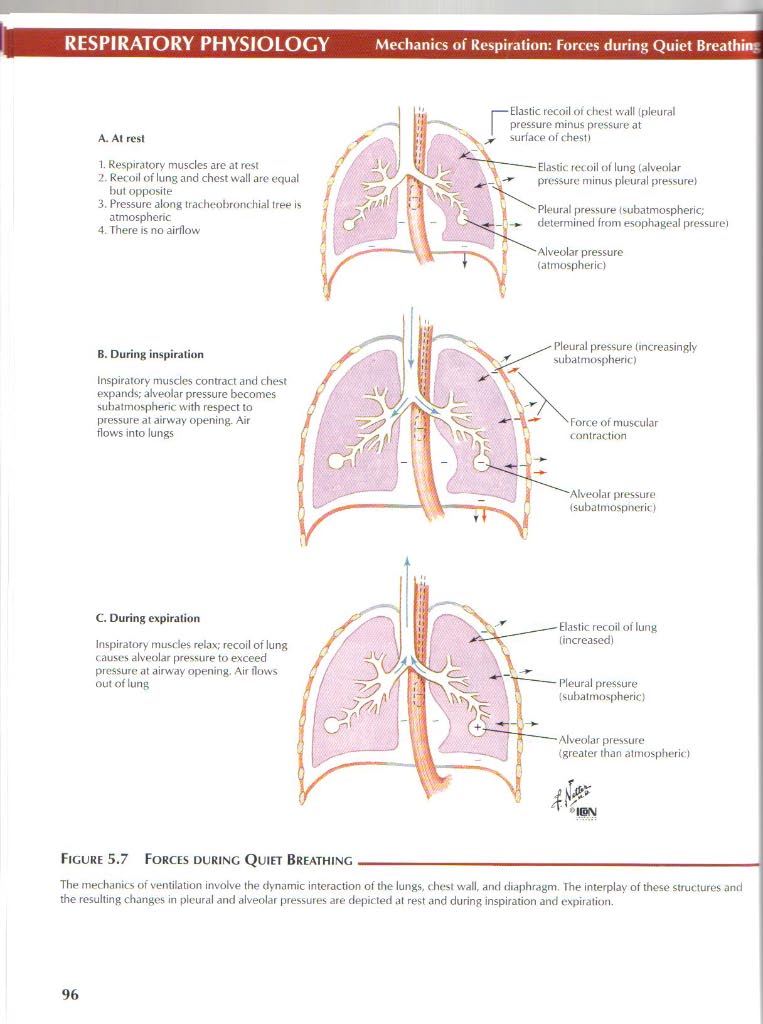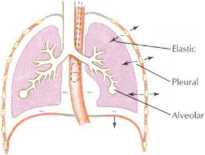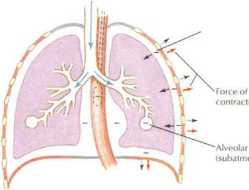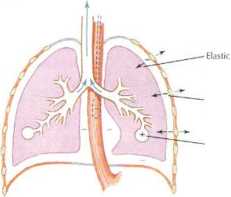45953 netter81

RESPIRATORY PHYSIOLOGY
Mechanics of Rcspiration: Forces during Quict Breathin

pressure isubatmospheric; determined from esophageal pressurei
A. Al rcsl
1. Respiratory muscles are at rest Recoil of lung and chcst wali are equal l»ul opposite
3. Pressure along trachcohroiu hial iree i*, atmosphcric
4. There is no airflow
rElaslic recoil of chust wali (pleural pressure minus pressure at surface of chest) recoil of luny (alveolar pressure minus pleural pressure)
pressure (atmospheric)

Pleural pressure tincreasingly subatmuspheric)
B. During inspiration
Inspiratory muscles contract and chest expands; ahreolar pressure becomes subalmosphenc with respect to pressure at airway opening. Air flows into lungs
C. During expiration
Inspiratory musdeS relax; recoil of lung t.ausos akeolar pressure to exceed pressure at airway opening. Air llows out of lung

Pleural pressure (subalmospheric)
Alveolar pressure (greater than atmospłierir l
recoil of lung (increased)
Figurę 5.7 Forces during Quiet Breathing_
The mechanics ot ventilation involve the dynamie interaction of the lungs, chest wali, and dia|)hragm. The interplay of these structures and the resulting changes in pleural and alveolar pressures are depic ted at rest and during inspiration and CKpiration.
Wyszukiwarka
Podobne podstrony:
netter85 RESPIRATORY PHYSIOLOGYMechanits of Respiration: Airway Flo» Laminar flow occurs mainly in s
82393 netter97 RESPIRATORY PHYSIOLOGYRole of the Lungs in Acid-Base BaLar A. Role ot Lungs and Kidne
netter89 RESPIRATORY PHYSIOLOGY Pulmonary Circulation Distribution of Pulmonar> Blood Flow
netter86 . et tianics of Rcspiration: Flow-VolumeRESPIRATORY PHYSIOLOGY V high lung vołumes, ratę of
netter77 RESPIRATORY PHYSIOLOGYAirway Struclure: Intrapulmonary Airways Segmental bronchus Largo sub
netter87 RESPIRATORY PHYSIOLOGYIntrapulmonary Circulatior Pulmonary voin Bfonchial artery (from left
netter103 RESPIRATORY PHYSIOLOGYPulmonary Function Testing—cont d Mguimol «pBu!oc>
więcej podobnych podstron